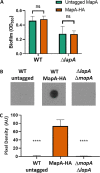MapA, a Second Large RTX Adhesin Conserved across the Pseudomonads, Contributes to Biofilm Formation by Pseudomonas fluorescens
- PMID: 32631946
- PMCID: PMC7925077
- DOI: 10.1128/JB.00277-20
MapA, a Second Large RTX Adhesin Conserved across the Pseudomonads, Contributes to Biofilm Formation by Pseudomonas fluorescens
Abstract
Mechanisms by which cells attach to a surface and form a biofilm are diverse and differ greatly among organisms. The Gram-negative gammaproteobacterium Pseudomonas fluorescens attaches to a surface through the localization of the large type 1-secreted RTX adhesin LapA to the outer surface of the cell. LapA localization to the cell surface is controlled by the activities of a periplasmic protease, LapG, and an inner membrane-spanning cyclic di-GMP-responsive effector protein, LapD. A previous study identified a second, LapA-like protein encoded in the P. fluorescens Pf0-1 genome: Pfl01_1463. Here, we identified specific growth conditions under which Pfl01_1463, here called MapA (
Keywords: Pseudomonas fluorescens; RTX; adhesin; biofilm; cyclic di-GMP.
Copyright © 2020 American Society for Microbiology.
Figures











Similar articles
-
The regulator FleQ both transcriptionally and post-transcriptionally regulates the level of RTX adhesins of Pseudomonas fluorescens.J Bacteriol. 2023 Sep 26;205(9):e0015223. doi: 10.1128/jb.00152-23. Epub 2023 Sep 1. J Bacteriol. 2023. PMID: 37655913 Free PMC article.
-
An N-Terminal Retention Module Anchors the Giant Adhesin LapA of Pseudomonas fluorescens at the Cell Surface: a Novel Subfamily of Type I Secretion Systems.J Bacteriol. 2018 Mar 26;200(8):e00734-17. doi: 10.1128/JB.00734-17. Print 2018 Apr 15. J Bacteriol. 2018. PMID: 29437852 Free PMC article.
-
A c-di-GMP effector system controls cell adhesion by inside-out signaling and surface protein cleavage.PLoS Biol. 2011 Feb 1;9(2):e1000587. doi: 10.1371/journal.pbio.1000587. PLoS Biol. 2011. PMID: 21304920 Free PMC article.
-
From Input to Output: The Lap/c-di-GMP Biofilm Regulatory Circuit.Annu Rev Microbiol. 2020 Sep 8;74:607-631. doi: 10.1146/annurev-micro-011520-094214. Epub 2020 Jul 20. Annu Rev Microbiol. 2020. PMID: 32689917 Free PMC article. Review.
-
Type 1 Does the Two-Step: Type 1 Secretion Substrates with a Functional Periplasmic Intermediate.J Bacteriol. 2018 Aug 24;200(18):e00168-18. doi: 10.1128/JB.00168-18. Print 2018 Sep 15. J Bacteriol. 2018. PMID: 29866808 Free PMC article. Review.
Cited by
-
Role of extracellular matrix components in biofilm formation and adaptation of Pseudomonas ogarae F113 to the rhizosphere environment.Front Microbiol. 2024 Jan 25;15:1341728. doi: 10.3389/fmicb.2024.1341728. eCollection 2024. Front Microbiol. 2024. PMID: 38333580 Free PMC article.
-
Absence of biofilm adhesin proteins changes surface attachment and cell strategy for Desulfovibrio vulgaris Hildenborough.J Bacteriol. 2025 Jan 31;207(1):e0037924. doi: 10.1128/jb.00379-24. Epub 2024 Dec 31. J Bacteriol. 2025. PMID: 39745371 Free PMC article.
-
Architecture of cell-cell junctions in situ reveals a mechanism for bacterial biofilm inhibition.Proc Natl Acad Sci U S A. 2021 Aug 3;118(31):e2109940118. doi: 10.1073/pnas.2109940118. Proc Natl Acad Sci U S A. 2021. PMID: 34321357 Free PMC article.
-
Multiple Pathways Impact Swarming Motility of Pseudomonas fluorescens Pf0-1.bioRxiv [Preprint]. 2024 Jan 18:2024.01.17.576057. doi: 10.1101/2024.01.17.576057. bioRxiv. 2024. Update in: Microbiol Spectr. 2024 Jun 4;12(6):e0016624. doi: 10.1128/spectrum.00166-24. PMID: 38293239 Free PMC article. Updated. Preprint.
-
Pseudomonas putida Biofilm Depends on the vWFa-Domain of LapA in Peptides-Containing Growth Medium.Int J Mol Sci. 2022 May 24;23(11):5898. doi: 10.3390/ijms23115898. Int J Mol Sci. 2022. PMID: 35682576 Free PMC article.
References
Publication types
MeSH terms
Substances
Grants and funding
LinkOut - more resources
Full Text Sources
Molecular Biology Databases
Research Materials

